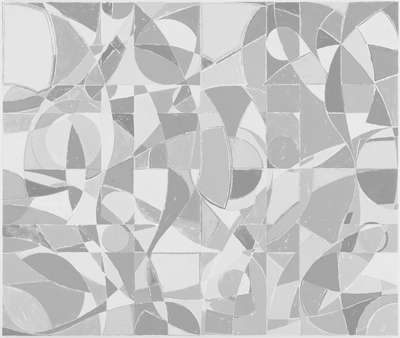

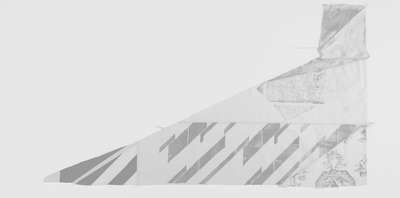
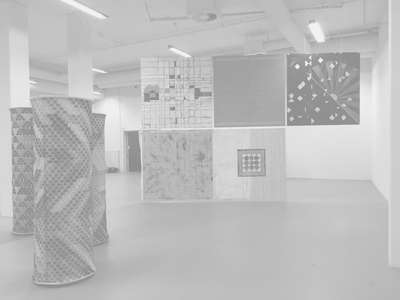
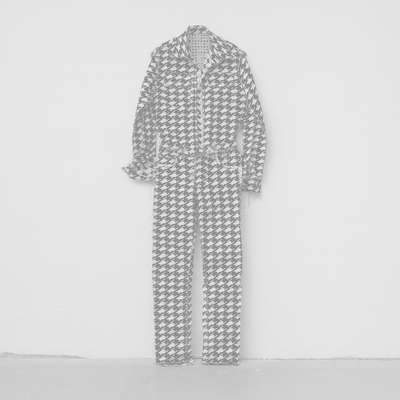
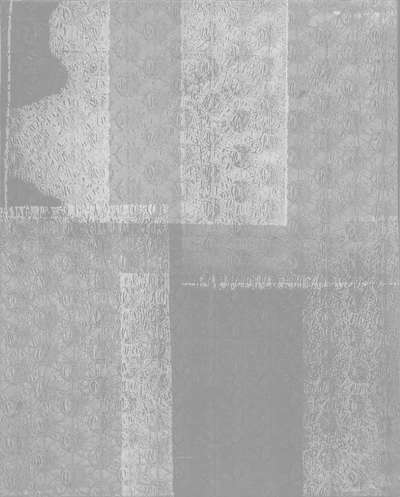
“The others just saw a bunch of lines, whereas I saw a clearly coherent drawing”, 2013
Solvej Helweg Ovesen
This is how artist Mette Winckelmann describes the moment when she first recognised that her desire to split things up was in fact her artistic weapon. To her, the geometric division of any given ‘territory’ – whether it be canvas, a piece of fabric or any other surface – is equal to the appropriation of a private space:
“Adopting such an approach to the canvas is a way of capturing it. For the majority of my works, projects and exhibitions I begin by dividing material, the canvas, the room or the floor space into sections. For example, I measure up a canvas and draw precise lines dividing the surface into halves, thirds and quarters, which I then mark off and work further with. This marking off of sections is not only my way of organising the surface, but also serves as a basic grid – a skeleton that I perceive as already existing and which my division merely emphasises. For me, this is closely connected with the structure of the body, which we as humans depend upon and which both offers us freedom to manoeuvre and constrains us.”
How is it possible to explain the pleasure that arises from creating a grid? Like the feeling of quiet delight or relief that comes from getting things your own way? Or like winning a battle that you have had with yourself, or is it more like the feeling of living freely from how others have imagined your life? – Is it possible to compare these feelings with the pleasure of having a canvas at your disposal and dividing it up?
“The division or the grid, which is the first stage of the work, is just one stage in the process of unleashing something that is otherwise static”, explains Winckelmann. “It’s a feeling of clearness and logic that emerges when I do it – the only right thing to do. I also believe that it provides a stimulus on a mental and spiritual level for both myself and others – drinking it in through the eyes, not as a specific point being lectured to us, but more as a form of stimuli or mental massage.”
Perhaps the mental massage arises from the visual confusion – the moment when we lose our focus – that occurs when we look at a painting such as 2013 work The Four Parts. The painting is divided into a fundamental, hand-held grid that is spaced across the entire surface. Here it is the interplay between the straight, tightly structured lines and the organic, flowing lines that creates, for the outsider, the work’s somewhat indecipherable element. It is as if the eye gives up trying to make sense of the pattern and the material, instead resigning themselves to focussing on the image’s inscrutable and unmanageable paths and layers. The same occurs when we follow the twisting movements in the vertically directed painting “The Turn of the Screw” from 2013, and allow ourselves to be surprised by its colouristic transition from rust to light pastels. At the same time, there is a certain transparency in the materials of the work as it is important, the artist states, that “[…] the layers remain open and that it is clearly possible upon close inspection to decode every individual layer, and consequently, the process by which the work came into being.” The grid and the division of the different parts are also central elements within a sculptural work, such as “Used in Denmark”, 2012, which is made as a triangular platform of coloured tiles that are heated from within and upon which we can sit. The grid is present as it is in the other works, yet here it occurs “around the form or within it, so it can be cut like a cake”, as Winckelmann puts it, continuing, “there are other subdivisions that mix with the fundamental grid, but always some which also relate to the format or the body from which the work derives.”
But the grid is something that comes and goes. In the new 2013 work “The Shape of Things to Come”, which at a distance looks like a white monochromatic picture, the grid first becomes visible when we get up very close to the picture. Here, the dissected fields of fabric fold around the demarcating pencil-drawn marks in the picture. The grid can always be shifted, and here the pieces have been layered in a procedural system which relates to the corners and rotates in relation to the format. The same is true for “Fall” 2013, which has been created using a pencil, acrylic paints and gesso on canvas and which appears as a meditation on the theme of grey tones and pastels. The result is an ephemeral, calming space, where angles and edges are subdued by soft fabric edges and three large integral circles. Winckelmann’s works are always incomplete – more and more layers can be added or removed before the work is presented, which is one of the refined artistic gestures behind “The Shape of Things To Come” and “Fall“ The Combination of painting and collage, as seen here, is a new development in the artist’s body of work.
The aesthetic and captivating work “Lucky Pieces” from 2013 has also been created using this painting-collage style but is more focussed on the spatial element. Here, several principles and pattern-logics of varying scales overlap and frame a grid-divided painting; slowly a magical vibration between different spaces and logics arises, despite the dominant central oval form.
“For me, the act of dividing up a surface offers the possibility of being able to change things and re-do things, like opening up a work, seeing it as a potential with many possibilities. It’s like seeing your own and others’ material as something flexible over time and space.”
For Mette Winckelmann, dissolving of static or monumental forms is a practice she adopts again and again, and she is constantly creating ‘double works’ which erode the idea of a singular masterpiece. For over a decade Winckelmann has been producing collages which are copied as paintings, or vice versa. The two similar appearing of works called “Let’s Talk About Sex” from 2009, which is a collage, and the painting “Push It” from 2009, are reflections of each other despite the fact that the two differ in terms of materials and medium – but this is the precise meaning of them: when they hang together in an exhibition, it takes a moment for a viewer to connect the two together and see the doubling. They are not exact copies of each other. The titles are not opposites, nor are they the same, but they clearly relate to one another.
Mette Winckelmann herself believes that the root of her obsession – the slightly vicious, masochistic dividing up of surfaces into quadrangles, triangles and circles that has characterised her work for years – lies within her ingrained desire to split things up. It is a desire to set free and release, for example releasing a shirt from its shape, taking the material back to something reminiscent of its past form or something else completely as in her 2008 work “What is Left of A Man’s Shirt?” Here, all of the component parts of a man’s shirt have been abstractly cut out of a blue fabric which then forms the background of the work. Both body and machine are in dialogue with one another, and the two are integrated in a new context. Things are freed from themselves. Even the work itself as an original is released from the hierarchical position – thinking of the double-works – and is represented as palpably tactile, artistic surfaces, which at times greedily take over the space around them.
“When the picture is successful it spreads itself throughout the room, beyond the confines of its own frame”, explains Winckelmann. The artistic element of this for her lies in the division of space, canvases, surfaces, pieces of fabric, and putting these together again and creating new layers. On rare occasions, she deliberately finishes off a work with a one-sided pattern at the edge of the frame or in time. She usually allows a pattern to appear as if it extends beyond the edge of the work, giving us the impression that we are only able to see one small bit of it, as in the 2011 work “Carpet of Every Moment”. The cut of the axes of this work lie outside the frame, and its intricate pattern appears completely unfathomable. What a level of optical vertigo an artwork would really evoke if it really did continue on forever into infinity. Several of the works and objects created by Winckelmann possess a spiritual, perhaps liberating, visual and emotional effect. Not least, her works suggest an unending and non-hierarchical space: a sanctuary. “Crosses and Losses” from 2012 is a work that has inherited its title from a patchwork block and consists of pastel-coloured shirt swatches organised in a simple grid, yet touched by an external event, hand or order whose almost ephemeral traces (hints of black lines) merely suggest a block, a weave, that extends way beyond the surface of the work.
What does a square mean in relation to a circle? If triangles, squares and circles in themselves have a meaning – or moreover take on a meaning when seen or understood as part of a patchwork, pattern or artistic context – what are the intimate relationships between the parts? And what does this mean for the work in its entirety?
“I’ve always had a natural relationship to mathematics and systems. Both as a child and as an adult, I’ve studiet and felt drawn to these shapes, and I’ve always considered them to be completely fundamental factors for body and spirit. In their ideological construction, triangles, squares and other geometric shapes represent a language or a family, who because of each other justify or explain the existence of each other. At the same time, each is a symbol of very different phenomena and a recognisable body which conveys something special. The geometric shapes have an outline that we with our human bodies also physically relate to. I’ve worked with fabric for as long as I’ve been drawing, since childhood, and I’ve had the same desire to split things up whether these things be long rolls of fabric, discarded jeans, or a picture where the lines have been dissolved by an undefined motif. I wasn’t aware of it myself, but when I went to art school at the age of 18 and heard that the others just saw a bunch of lines whereas I saw a clearly coherent drawing, I began to become aware of my way of looking at things and my special interest in that which has been dissolved or opened up.”